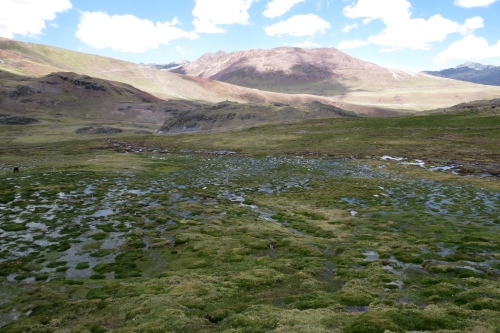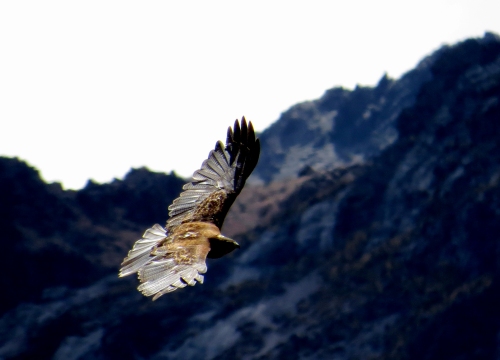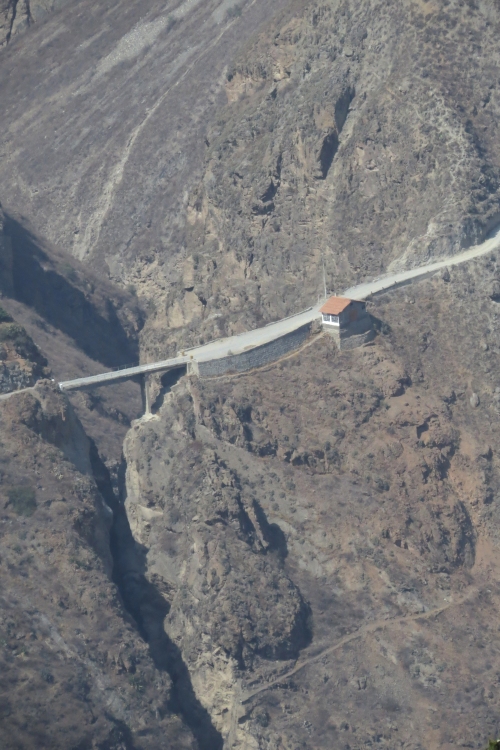This post covers our final leg of the trip, back westwards to the continental divide and the descent to San Mateo with birding over the following two days at Marcapomacocha and the Santa Eulania Valley.

Following on from the last post we climbed out of the humid subtropics and headed westwards towards the high Andes.

Soon we were out of the cloud and back in puna grassland.

Domesticated llamas replace sheep at these altitudes.

Llamas were almost certainly domesticated from the Guanaco, whilst the wool bearing Alpaca originated from the Vicuña.

A Variable Hawk watched us from a nearby ridge. Formerly treated as two species the lower elevation Red-backed Hawk and high elevation Puna Hawk; it was shown a decade or so ago that there were no consistent differences between the two and they were lumped under the name Variable Hawk. Back in 1989 as we climbed the Andes on my first visit to Peru, I asked the leader how you separated the two. ‘Easy’ was his reply, they are Red-backed before the lunch stop and Puna afterwards!

It was a long, but scenic drive punctuated with birding stops but became easier as the latter part was on tarmac. However we did meet some serious congestion when we reached the Central Highway.

We were running short of daylight when we reached the continental divide at Ticlio Pass at an altitude of 4828m but we did have a short stop at Ticlio Bog.

In spite of the late hour we had good views of White-bellied Cinclodes, a critically endangered species restricted to a few high altitude bogs in Central Peru. (Photo taken the following day in good light). The world population may be as low as 50 pairs as the bogs are suffering from overgrazing, drying out – in the long term due to climate change (all are fed from glacial meltwater from glaciers that will eventually disappear) and in the short term, the effects of La Niña.

We had to descend for about an hour to San Mateo for the night. The next morning we retraced our steps back up to the pass and along a side road. At least we didn’t have to be there for dawn as there is virtually no bird activity that early on at these altitudes.

We soon started seeing cracking new birds like this Junin Canastero …

… Dark-winged Miner …

… and at the highest of the bogs – Andean Snipe …

… and another couple of pairs of White-bellied Cinclodes. For a critically endangered bird they were remarkably easy to see.

Dave, one of the participants, using a GPS to track our journey, declared that we were at 4898m asl. This was the highest I have ever been. However I realised that if I climbed two metres up this rock I could reach a nice round 4900m. I have often wished I could reach 5000m but there is no way I could climb a further 100m vertically. That said I had acclimatised and could walk about without the extreme shortage of breath and headaches that occurred at the start of the trip.

The acclimatisation was to be put to good use as our next stop was the bog at Marcapomacocha.

Whilst it was a couple of hundred metres lower than the Andean Snipe site we were to spend several hours jumping from one tussock to the next as we searched for our target species.

The meltwater from the glacier spreads out forming this hillside of shallow puddles interspersed with tussocks and cushion plants.

Of course there were common Andean wetland species like Andean Goose ….

… and Puna Ibis …

… whilst a Variable Hawk soared overhead.

With all dark underparts this was a very different bird than the one we saw the yesterday (hence the name). With so much variation in all populations it is understandable that the two former species were lumped, but on altitude alone this one would certainly qualify as a ‘puna’ hawk.

White-winged Duica Finches were common.

Although the epithets ‘white-winged’ and ‘finch’ are self-explanatory, no-one seems to know the origin of the world ‘duica’.

In the drier areas around the bog we saw several small groups of Rufous-bellied Seedsnipe, the third sneedsnipe species of the trip (the only other one White-bellied, is only found in the far south of South America).

There were several species of ground-tyrant on the bog, the neotropical equivalent of the wheatears, this is a Cinereous Ground-tyrant. Had we come in the austral winter then the place would have been stacked with various ground-tyrant species as many migrate north from Patagonia seeking the comparatively mild conditions of the central Andes.

After some searching we eventually found the main prize …

… the exquisite Diademed Sandpiper Plover …

… one of the most beautiful waders in the world. It has a wide range from Peru to Chile but occurs only sparsely in high altitude bogs. For me it tied with Junin Grebe as ‘bird of the trip’ but it only came fourth in the group-wide poll.

With this gem securely under the belt we slowly descended to the Santa Eulania valley. On this dirt road it took several hours before we reached our next destination …

…. there were many distractions both avian and scenic.

Our driver Julio (L) and tour guide Eustace.

In the late afternoon we slogged up this gully at an altitude of about 4000m into the dwarf scrub (we are now of course on the dry side of the Andes so there is no temperate forest here).

As well as common and familiar species like this House Wren ….

…. we found the beautiful Pied-crested Tit-tyrant …

… surely one of the cutest of the 436 strong tyrant-flycatcher family.

A small flock of Spot-winged Pigeons was a surprise as they are mainly confined to the east slope of the Andes.

Our main target was this Rusty-bellied Brushfinch which was a life bird for me.

With the day drawing on it was time to head down to the town of Santa Eulania which at an altitude of a mere 1000m was a long way below.

Driving down these narrow dirt roads in the dark was quite scary (these photos were taken of the same area the following day).

I was at the back of the minibus and on the left so I could see directly down a 1000m or so to the river glinting in the moonlight.

We also had a puncture but fortunately not on of the perilous hairpin bends. All of the staff seemed to have left the hotel leaving only a night-watchman so it was a bit of a Fawlty Towers situation. We ordered in pizza for our evening meal and ate it out on the lawn.

The following morning we returned up the Santa Eulania road and took a side road to reach the other side of the valley.

We spent a few hours birding an altitude of about 3000m.

This Bronze-tailed Comet was a new bird for me as was the pretty, yet elusive Rufous-breasted Warbling Finch (but I didn’t get any photos of that one).

Again there were plenty of common species around such as this Chiguanco Thrush.

Lower down see saw this Pacific (aka Peruvian) Screech Owl.

We descended still further and crossed the valley via this bridge.

Views from the bridge in both directions were quite spectacular.

From here we joined up with the road that we used last night and returned to the hotel. We packed up and had a leisurely lunch before heading off to Lima for our final night in Peru.

….. but just before we left we had views of this female Peruvian Sheartail in the hotel garden – our last ‘quality’ land bird of the trip. Photo by tour participant Steve Lowe.

The drive back into Lima was, as expected slow and tedious but we arrived at the hotel with plenty of time for a clean up and a repack.
The trip wasn’t quite over, as although our land birding was over we had another day before our evening flight home and that would involve a pelagic out on the Pacific Ocean. The subject (of course) of the next post.
Looks like you had a great trip! I enjoyed seeing photos of what the habitat and scenery is like (in addition to the birds, of course). I’m thinking of taking some time from Lima and visiting the Santa Eulalia valley – was there a hotel in that area that you’d recommend to stay at for one night if I want to do a two-day trip in the vicinity? Thanks!
We stayed for one night at Hotel El Tinajon, Santa Eulalia (Tel: ++51-1-361-2571) It was fine but we arrived well after dark and the only staff present was the night watchman! We had to order in pizza and eat it sat on the lawn. The following day went out early and returned for an early lunch. Everything was ok then.
thanks for the information!